How Long Physical Therapy After Knee Replacement
How Long Physical Therapy After Knee Replacement Recovery after a knee replacement takes time and effort. It’s a journey that starts with surgery and continues with physical therapy. This process helps you get back on your feet and move more easily. Everyone wants to know how long they will need to focus on recovery. The answer depends on many things including how hard you work at it.
Physical therapy is key to healing well from knee surgery. In these sessions you’ll learn exercises that make your new knee stronger. Your therapist will guide you through movements that help improve flexibility and strength. They give support every step of the way so that each day gets a little easier.
Getting better after knee surgery means sticking with your therapy plan for as long as needed. Some people might feel good in just a few weeks while others may take longer. Ask questions during your visits to understand what comes next for you. Remember moving forward takes patience but leads to great results in the end.
Benefits of Physical Therapy
Physical therapy plays a big part in recovery after knee replacement. It aims to get your knee moving safely and to its fullest. A therapist will work with you on exercises that fit your needs. They know how the body heals and can help speed up your recovery. This support is vital for getting back to normal life.
The sessions are designed around your own pace and ability. As you get stronger, they become more challenging, helping you improve step by step. The goal is simple: make sure you can move without pain or trouble. Over time this care leads to better strength and balance.
Having someone guide you through each movement gives peace of mind during rehabilitation. They ensure that every exercise helps heal without hurting the new joint too much. Knowing what works best for a smooth recovery helps ease worries about doing too much or too little.
As days pass many see clear signs of progress from their physical therapy efforts after knee replacement surgery. Little wins add up; soon climbing stairs or walking longer distances won’t seem so tough anymore! Each session gets you closer to where you want to be – living an active life once again.
Duration of Physical Therapy
The length of time needed for physical therapy after a knee replacement varies. It often depends on how quickly your body heals and how well you respond to treatment. Most people need sessions for several weeks but some might need them longer. Your therapist will set goals tailored just for you during this period. The plan will change as you grow stronger and more able.
It’s common to have physical therapy multiple times a week at the start. As you make progress these visits may become less frequent. But even when the visits slow down home exercises are essential to keep improving. Your commitment outside of sessions plays a huge role in speeding up your recovery.
For many patients intense physical therapy lasts around six to twelve weeks after surgery. This phase focuses on getting back basic movement and strength in your knee joint. After this stage some may continue with lighter rehab work to support their ongoing healing process.
Remember that each person’s journey through rehabilitation is unique – there is no one-size-fits-all duration for therapy. Be patient with yourself and follow the advice of healthcare professionals closely throughout your recovery journey from knee replacement surgery.

Exercises and Techniques
In physical therapy after a knee replacement you’ll start with basic exercises. These first steps focus on getting your joint to move again. Simple bends and straightens of the leg help wake up your muscles. You might also work on gentle stretches to improve flexibility in the knee area. As these become easier you can try out more advanced moves.
Strength is important for a stable knee so therapists use specific techniques to build muscle. Leg lifts and presses against resistance help make your legs stronger over time. Balance exercises like standing on one foot are added as well. This helps prepare you for walking without support or doing other daily activities safely.
One key technique is teaching you how to walk correctly with your new knee joint. Therapists show patients how to stand tall and take even steps for less stress on the knee during recovery. They might use tools like treadmills or stairs in sessions too! These tools can give practice that feels much like real life challenges outside of therapy walls.
Monitoring Progress
Keeping track of your progress is a key part of physical therapy after knee replacement. At each session your therapist will check how well you can move and use your knee. They’ll measure things like the angle at which you can bend and straighten it. These numbers tell them how far you’ve come and what still needs work.
Your pain levels are also an important sign of your healing journey. Therapists ask about pain to make sure they don’t push you too hard during exercises. You might rate it on a scale or just talk about how it feels day to-day. This feedback helps adjust the plan so that each step in therapy aids recovery without causing extra hurt.
The strength in your leg muscles gets attention as well since they support the new joint. Tests might include seeing how long you can hold up your leg or checking if you can lift weights with it yet. Over time, these tests should show that your legs are getting stronger, making daily tasks easier for you.
How well you do certain movements is another way to see improvement during rehab from a knee replacement surgery. Can you walk steadily? Climb stairs without holding on? Each success points to gains made through hard work in therapy sessions.
Lastly therapists often set goals with their patients to keep them moving forward in recovery after knee surgery. Meeting these milestones gives clear proof of progress over time – like being able to stand longer without help or walking further than before! Your therapist will celebrate these wins with you and guide towards even bigger ones ahead!
Returning to Normal Activities
After knee replacement one of the main goals is getting back to your normal life. Physical therapy helps you reach this point step by step. At first you may be able to do simple things like walking around the house or cooking a meal. As time goes on and you work with your therapist these tasks will start to feel easier.
Your therapist will guide you on when it’s safe to take on more activities. They know what movements might put too much stress on your new knee at first. With their help you’ll learn which exercises can boost your recovery and get you back in action safely. This way they ensure that each new activity is good for your healing process.
Everyone wants to return to their hobbies and daily routines after surgery as soon as possible. Your progress in physical therapy plays a big part in when this happens for you. Just remember that being patient with yourself now can lead to better health and more fun down the road!
Frequently Asked Questions
How soon after knee replacement surgery can I start physical therapy?
Most patients begin physical therapy within 24 hours after surgery to promote movement and reduce swelling.
Will I need special equipment for my physical therapy exercises at home?
Your therapist might suggest simple items like a chair or pillow but they will guide you based on your specific needs.
How often do I need to do my physical therapy exercises?
The frequency of your exercises will be personalized by your therapist usually daily with specific routines to follow at home.
The answers are for informational purposes only and do not constitute medical advice.








